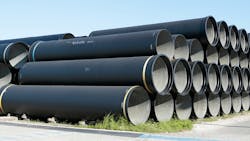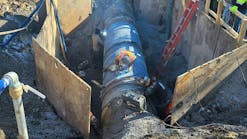SAN FRANCISCO, CA – The San Francisco Public Utilities Commission is set to use innovative piping with flexible joints that can bend to withstand seismic activity as part of the next phase of the College Hill Reservoir Water Distribution System improvements, a seismic upgrade project that includes connections to the Zuckerberg San Francisco General Hospital.
Manufactured by the Japanese company Kubota, the high-tech Earthquake Resistant Ductile Iron Pipe (ERDIP) has a unique segmented design that can expand and contract under the stresses of large ground movements caused by events such as earthquakes, landslides and temperature changes.
“On Sunday, we will mark the 115th anniversary of the 1906 Earthquake, and even though that event is more than a century old, we will never forget the lessons learned from that tragedy,” said SFPUC Acting General Manager Michael Carlin. “We understand the unique history of this city and know the importance of always planning for the next major earthquake and making key improvements in our infrastructure. These state-of-the-art pipes are part of our ongoing efforts to explore and invest in technologies that will ensure water reliability for our customers.”
Located in Bernal Heights, College Hill Reservoir is San Francisco’s oldest reservoir and a critical part of the SFPUC’s water system, responsible for delivering water to the eastern and northern areas of San Francisco, including General Hospital. Since 2015, it has been the focus of a series of phased improvements, including seismic improvements to the reservoir and outlet structure, and seismic upgrades to some of the major transmission pipelines in the College Hill pressure zone.
The current phase to start later this summer will include replacement of approximately 4,000 feet of piping with new ERDIP pipe along Cortland Avenue. Over the lifetime of the multiple phases of the College Hill Reservoir Water Distribution System improvements, crews plan to install a total of 14,000 feet of ERDIP.
Built to resemble a chain configuration, the ERDIP system is designed to remain intact, even when different sections move during a seismic event. Installed for more than 40 years in Japan, these Kubota ERDIP have not experienced a single break following major seismic events. Along with serving as the foundation for the College Hill Reservoir distribution system, the ERDIP have been installed in several other key locations throughout San Francisco.
“A safe, secure and resilient water system will save lives and reduce the impacts of a major earthquake on San Francisco residents and businesses,” said Mary Ellen Carroll, Executive Director, San Francisco Department of Emergency Management. “These continued improvements coupled with highly innovative advancements to our critical lifelines will help keep clean water flowing before, during and after an emergency.”
The SFPUC’s water system in the City and County of San Francisco includes approximately 1,200 miles of water pipeline. Laid end to end, these pipes could stretch all the way to Denver from San Francisco.
The SFPUC works to replace 12 to 15 miles of aging pipeline each year through projects like the College Hill Reservoir improvements through its ongoing capital program.



